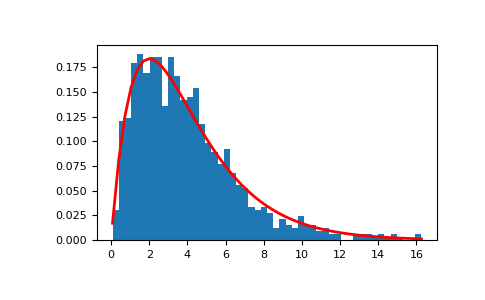numpy.random.gamma#
- random.gamma(shape, scale=1.0, size=None)#
从 Gamma 分布中抽取样本。
从具有指定参数
shape(有时表示为“k”)和 scale(有时表示为“theta”)的 Gamma 分布中抽取样本,其中两个参数都大于 0。- 参数:
- shapefloat 或 array_like 的 floats
Gamma 分布的形状。必须为非负数。
- scalefloat 或 array_like of floats, optional
Gamma 分布的尺度。必须为非负数。默认值为 1。
- sizeint 或 int 的元组,可选
输出形状。如果给定的形状是,例如,
(m, n, k),则抽取m * n * k个样本。如果 size 为None(默认),并且shape和scale都是标量,则返回单个值。否则,将抽取np.broadcast(shape, scale).size个样本。
- 返回:
- outndarray 或标量
从参数化的 Gamma 分布中抽取的样本。
另请参阅
scipy.stats.gamma概率密度函数、分布或累积密度函数等。
random.Generator.gamma新代码应使用此方法。
备注
Gamma 分布的概率密度为
\[p(x) = x^{k-1}\frac{e^{-x/\theta}}{\theta^k\Gamma(k)},\]其中 \(k\) 是形状,\(\theta\) 是尺度,\(\Gamma\) 是 Gamma 函数。
Gamma 分布通常用于模拟电子元件的故障时间,并在泊松分布事件之间等待时间相关的过程中自然出现。
参考
[1]Weisstein, Eric W. “Gamma Distribution.” From MathWorld–A Wolfram Web Resource. https://mathworld.net.cn/GammaDistribution.html
[2]Wikipedia, “Gamma distribution”, https://en.wikipedia.org/wiki/Gamma_distribution
示例
从分布中绘制样本
>>> shape, scale = 2., 2. # mean=4, std=2*sqrt(2) >>> s = np.random.gamma(shape, scale, 1000)
显示样本的直方图以及概率密度函数
>>> import matplotlib.pyplot as plt >>> import scipy.special as sps >>> count, bins, ignored = plt.hist(s, 50, density=True) >>> y = bins**(shape-1)*(np.exp(-bins/scale) / ... (sps.gamma(shape)*scale**shape)) >>> plt.plot(bins, y, linewidth=2, color='r') >>> plt.show()
